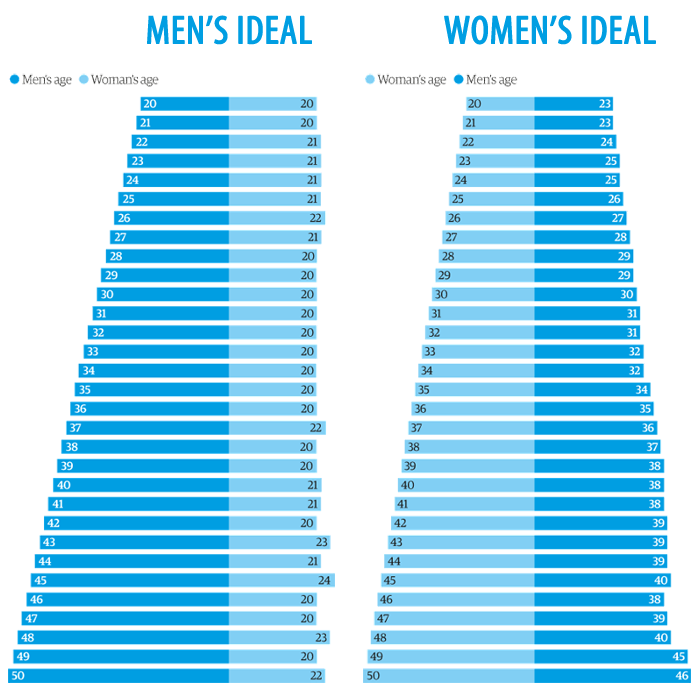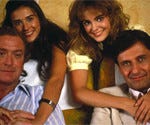Are men in romantic movies older than their female co-stars?

Last week, Oscar-nominated actress Maggie Gyllenhaal was widely quoted as saying that (by Hollywood standards) she is already "too old" to play the on-screen love interest of a 55-year-old man in romantic movies. She's 37. Following this, I have been asked by a few regular readers to crunch the numbers and look at whether there has historically been an age gap between male and female actors in romantic films.
So I built up a dataset of 422 romantic films ("rom coms" and romantic dramas) that grossed over $1m at the US box office and were released between 1984 and 2014. I then determined which two actors were the main heterosexual on-screen couple (details of the methodology is at the bottom of the article) and looked at the actors' exact ages when the film was released.
In summary
At no point in the past 30 years has the average annual age of female leads of these romantic films been older than the average age of their male counterparts.
On average, male leads in romantic films are 4.5 years older than their female co-stars
The age gap is slightly smaller on films directed by women
Women have directed 12% of romantic films between 1984 and 2014
Robert Redford, Dudley Moore and Richard Gere have the largest age gaps among male leads
Julia Roberts, Debra Winger and Winona Ryder are normally much younger than their male co-stars
The men have always been older
At no point in the past 30 years has the average annual age of female leads of these romantic films been older than the average age of their male counterparts. On average, the age difference between 1984-2014 is 4 years, 6 months and 29.6 days.
By contrast, the real-life age difference in England and Wales is 2.6 years, according to the Office for National Statistics.
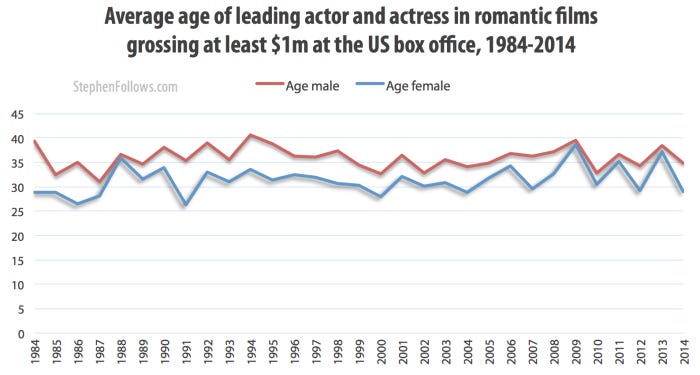
The closest was in 1988 and 2009 when the men were just 0.6 years and 0.8 years older, respectively (that's 219 and 292 days, for data pendants). The years with the greatest gaps were 1984 and 1991, with 10.4 years and 9.2 years (Want it in days? Course you do... 3,781 and 3,344 days).
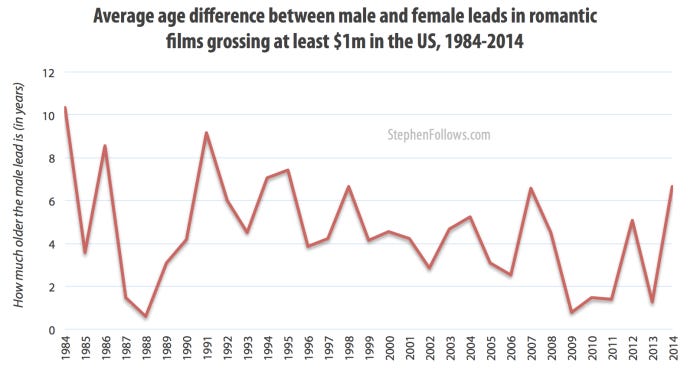
The dystopian world romantic movies in 1984

1984 saw the release of a crop of romantic comedies which paired particularly older men with much younger women, including...
Micki + Maude - Dudley Moore (49) and Amy Irving (31)
Unfaithfully Yours - Dudley Moore (50*) and Nastassja Kinski (23)
The Woman in Red - Gene Wilder (51) and Kelly LeBrock (24)
Blame It on Rio - Michael Caine (51) and Michelle Johnson (18)
*my research looked at the exact age of the actors/ actresses upon the film's release and Dudley Moore had a birthday between his two films on this list.
Before conducting this research I had never heard of Blame It On Rio but I was rather surprised to learn about this "light-hearted romantic comedy". The romantic couple are a 51-year old Michael Caine and 18-year old Michelle Johnson. According to Rob Hartill on IMDb, the plot is as follows...
Caine plays a man on holiday in Rio with his best friend. Both men have teenage daughters with them. When Caine falls for the amorous daughter (played by Michelle Johnson) of his best friend, they embark on a secret, if slightly one-sided relationship. Johnson's father is furious when he finds out about the 'older man' in his daughter's life, and sets out to hunt him down with the aid of Caine!
Not only does teenager female lead implausibly chase a man well over twice her age, but she does so in some cases while topless. Not quite the kind of 'romantic comedy' cinema-goers would expect today!
Does the gender of the director change the situation?
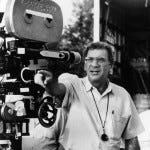
Ever so slightly, yes. I have written extensively in the past about the under-representation of women in the industry (here, here, here and here) so it will come as no surprise to regular readers to learn that 88% of the films I studied were directed by men. Of the directors who had directed at least three of the films on my list, Sydney Pollack had the largest average age gap, at 16 years and 5 months.
On average, the male leads in films directed by men were 4.53 years older than their female co-stars. In films directed by women, the male leads were 4.16 years older than the female leads.
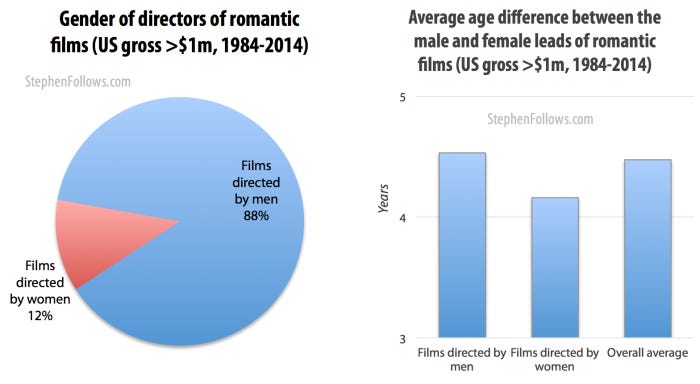
Which actors / actress have the largest age gap?

I took a look at the most featured actors and actresses within my 422 romantic films and at the average age difference in their films. Robert Redford and Dudley Moore are the men with the highest average age difference between themselves and their female co-stars (20 years and 18 years, respectively).
The only women to have appeared in four or more of my films and to have a higher average age than their male counterparts were Goldie Hawn (8 months older, on average) and Sandra Bullock (1 year and 4 months older).
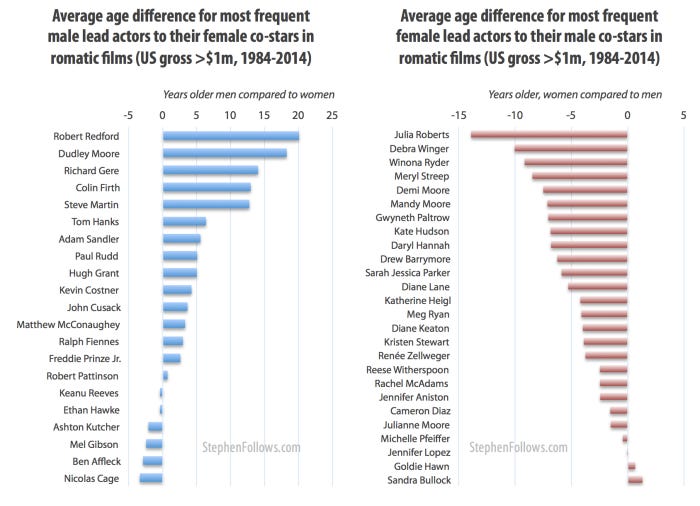
What else can we learn about romantic films?

In order to conduct today's research I built up a dataset of 444 films all of which grossed at least $1million at the US box office, had a romantic genre attached on Box Office Mojo (see full methodology later in this article) and have a clear male/ female relationship at their heart. While we cannot use this to make definitive statements about all romantic films (my criteria for the dataset was a bit too specific for that), nonetheless it is still interesting to look at other aspects of my dataset.
69% were romantic comedies and 36% romantic dramas. The overlap is due to 22 films which I feel should be classified as both comedies and dramas, such as Sliding Doors.
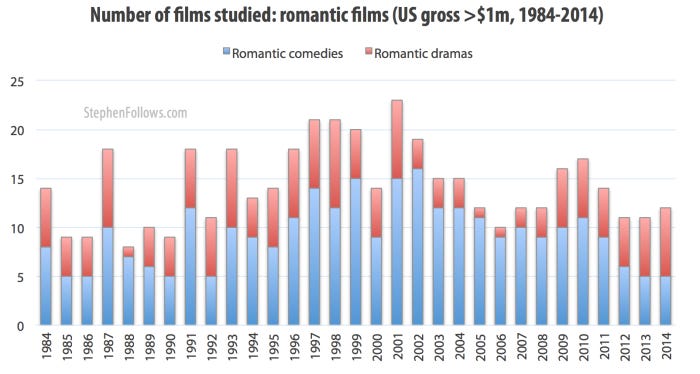
54.8% were rated PG-13 by the MPPA, 28.5% were rated R, 15.7% were rated PG and just two received an NC-17 rating (Wide Sargasso Sea and Blue Valentine).
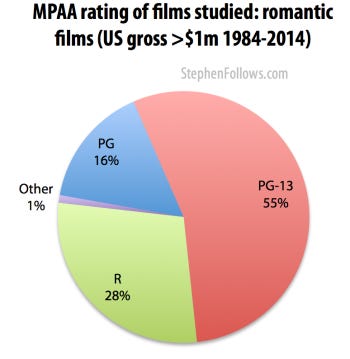
The average running time across all romantic films studied is 107 minutes. On average, 'romantic comedies' were shorter (103.3 minutes) than 'romantic dramas' (113.2 minutes).
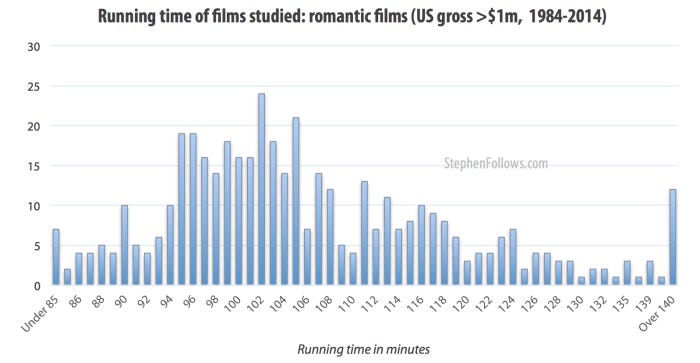
Notes and Caveats
This research is looking at a particular subset of films and comes along with various definitions and restrictions, including...
Selecting the films to study. Defining exactly what a romantic film is, is harder than it at first seems. I initially turned to IMDb and Wikipedia but both are very liberal with their genre term 'Romantic'. In the end I chose to use the criteria given by Box Office Mojo for their sub-genres of Romantic Comedy, Crime - Romantic Comedy, Romantic Comedy - Fantasy, Romantic Drama and Romantic Fantasy. I used these to create two master lists for my research, that of Romantic Comedy and Romantic Drama.
Removing non-relevant films. I excluded 34 films from the Box Office Mojo lists as they did not fit my criteria of a romantic film having two clear leads, one male and one female. I did not include gay love stories as (a) there are sadly so few and (b) it doesn't speak to the exact topic I'm researching today, i.e. gender inequality on screen. Some films were excluded because there was not one clear couple, such as ensemble films like New Year's Eve and Love Actually and films about love triangles such as Keeping the Faith and Threesome.
Relevant dates. My initial dataset spanned over fifty years of films but in the end I decided to focus my research on films released between 1984 - 2014 inclusive, leaving me with 422 films to study. Interestingly, the data I have suggests that 1983 was the only year in the past 35 years when female actresses in romantic films have, on average, been older than their male counterparts. Sadly I don't feel that this result is anything significant as there were only a small number of films in my dataset for that year. In order to be able to rely on this figure, further research is needed to ensure a comprehensive look at romantic films released in 1983. The films from that year with the largest age gap between an older woman and younger man were Two of a Kind (35 year-old Olivia Newton-John playing opposite 30 year-old John Travolta) and Valley Girl (21 year-old Deborah Foreman and 19 year-old Nicolas Cage).
Defining the release date. For the official 'date of release' I used the first time the film was screened to the public in a commercial cinema. For most films, this was their USA release date (95.3% of films, to be exact). If IMDb and Wikipedia disagreed then I took the earliest date.
Defining 'the main couple'. I chose the relationship which we as the audience are rooting to succeed. I.e. In Win a Date with Tad Hamilton! (2004) we are rooting for Topher Grace's best-friend character, rather than the celebrity played by Josh Duhamel. Similarly, in the Bridget Jones films it is Colin Firth, and not Hugh Grant, who will be measured in this research. For films I'd not seen and was not sure about, I usually went to the plot breakdown on Wikipedia and read the final few paragraphs.
Studying the age of the actor/ actress, not the characters. Many people look older or younger than their true age and so if we want to measure representation of relationships on screen then character age might be a more effective metric. Sadly, I can't think of a way of measuring it without researching the backstory of each character in each film so the actors' ages will have to stand in as a proxy for now.
Determining the performer's age. I compared the age of the actor/actress on the first day the film was screened to the public.
Dates of birth. For five performers I could only ascertain a year of birth and so I set their birthdays to 1st January.
Epilogue
Today's subject is exactly the type of topic I enjoy researching. The answers are quite clear, datawise, but what they mean is open for discussion. Art and culture influence how we live our lives and what we regard as "normal", and the film industry is a big part of that.
Dating giant OkCupid asked men and women what age their find people of the opposite sex most attractive. A woman of 20 is apparently most interested in guys aged 23. This rises as the woman ages; a 30 year old woman wants a 30 year old man, at 40 they're after a 38 year old man and at 50 their Mr Right is 46.
Men, on the other hand, are always after a woman aged around 21, no matter how old the man gets!
